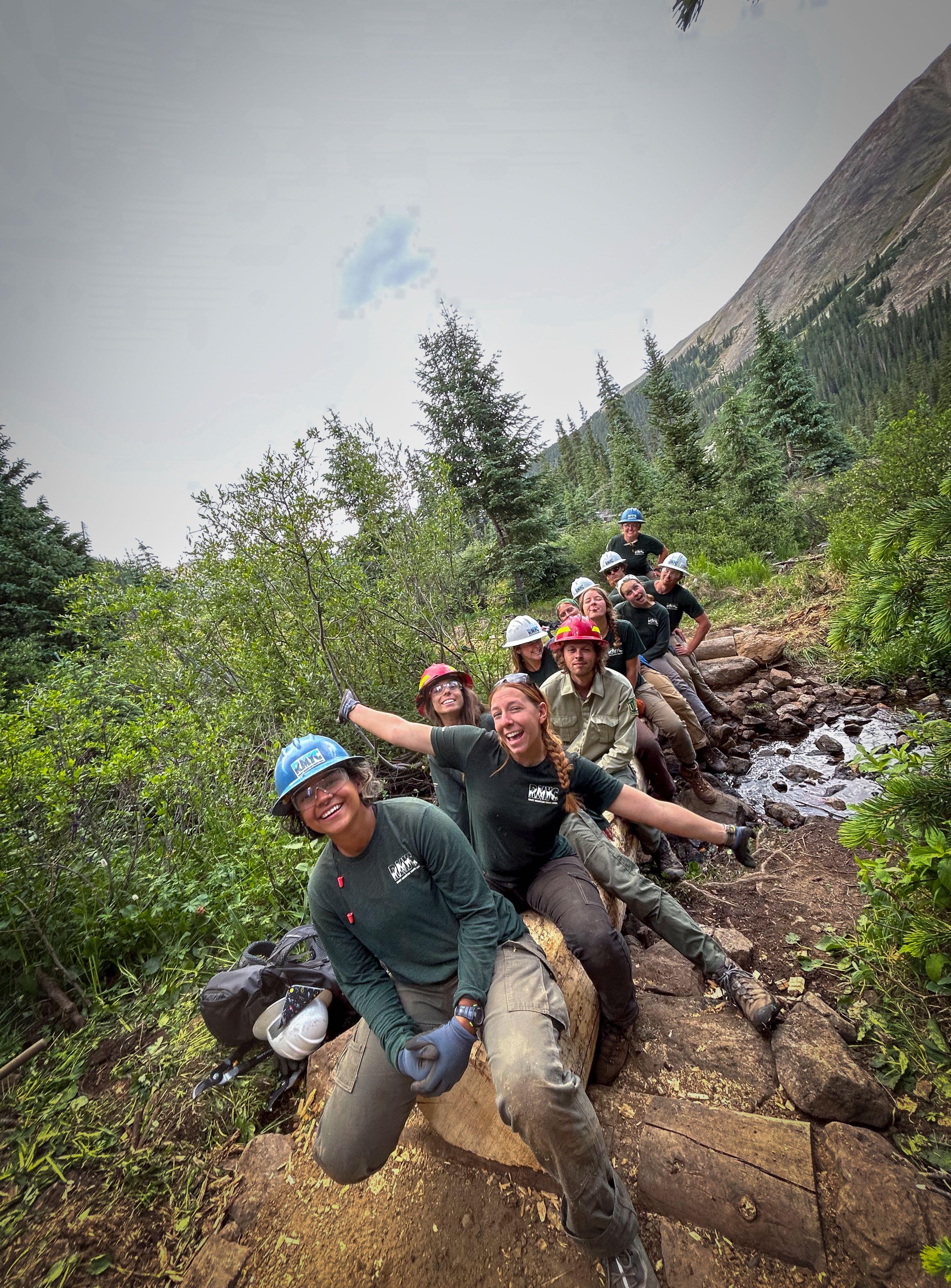
Forging paths through service






Forging paths through service




By Kent Singer Executive Director

Iattended my first major league baseball game in 1965 when my family made a trip from Topeka, Kansas, to watch the Kansas City A’s play in the old municipal stadium in downtown Kansas City.
I don’t remember who the A’s played that night or any of their players — except for Campy Campaneris — but I remember very clearly the mule Charlie O., the team mascot. Charlie O. was named after A’s owner Charles O. Finley, who was something of a Barnum & Bailey-style team owner. I also remember that instead of a ball boy delivering new baseballs to the home plate umpire, a device would rise out of the ground behind home plate with a basket of baseballs served up on the outraised arm of a mechanical rabbit named Harvey (yes, after the Jimmy Stewart movie). The A’s stunk, but Mr. Finley wanted patrons to have a good time.
The A’s left for Oakland, California, after the 1967 season, and Kansas City was left without a baseball team until 1969 when the Kansas City Royals arrived, and a fancy new stadium was built. The Royals had a lot of success in the late 1970s, but lost three straight years in the American League Championship series to the dreaded New York Yankees — their formidable rival. Those Royals teams had great players including Frank White at second base, Freddie Patek at short, Amos Otis and Willie Wilson in the outfield, and, of course, the incomparable George Brett at third.
When I moved to Colorado in the mid-1980s, I continued to be a Royals fan until Denver was awarded the Colorado Rockies franchise and they began to play in 1993. I’ve been a Rockies fan ever since, although heaven knows in recent years that seems to be something of a fool’s errand. While listen-
ing to a recent Rockies game, however, I was reminded why I continue to love baseball: It takes me back to my youth.
On June 10, the Rockies took a 5-2 lead into the top of the ninth against the San Francisco Giants. Aided by walks and wild pitches, the Giants rallied to score four runs, capped by a two-out, two-run single by Giants outfielder Mike Yastrzemski. For those of us who grew up with baseball in the 1960s, the Yastrzemski name is legendary. Mike’s grandfather, Hall of Famer Carl Yastrzemski, was one of the all-time greats for the Boston Red Sox. “Yaz,” as he was known, was an 18-time All-Star, a member of the 3,000-hit club, and the winner of seven Gold Glove awards. My mother, an avid baseball fan who listened to every Royals game on the radio with my dad, was always amused trying to pronounce the names of some of those mid-60s Red Sox players including Yastrzemski, Rico Petrocelli, and Tony Conigliaro.

So, while we suffer through another tough Rockies season, we can at least be reminded of the links to the past and hope for better days ahead. There’s always next year!
Kent Singer is the executive director of CREA and offers a statewide perspective on issues affecting electric cooperatives. CREA is the trade association for 21 Colorado electric distribution co-ops and one power supply co-op.
By Kevin Brandon CEO
When outdoor temperatures soar, our electricity use increases. That’s because our air conditioners are running longer and more often to counteract sweltering outdoor temperatures. Factor in that we all tend to use electricity at the same time — in the morning and early evenings — and that puts a lot of strain on our electric grid.

At Southeast Colorado Power Association (SECPA), we work closely with Tri-State Generation and Transmission, our local power supplier, in resource and infrastructure planning to ensure you have the power you need whenever you flip a switch. But the electric grid is much larger than your local co-op and G&T.
In summer months, when even more electricity is being used simultaneously across the country, it is possible for electricity demand to exceed supply, especially if a prolonged heat wave occurs. If this happens, the grid operator for our region may call on consumers to actively reduce their energy use or initiate rolling power outages to relieve pressure on the grid. SECPA will always keep you informed about situations like this, but it is very rare to see rolling outages in our area.
To help keep the air conditioner running for you, your family, and neighbors, here are a few things you
can do to relieve pressure on the grid during times of extreme summer heat:
• Select the highest comfortable thermostat setting and turn it up several degrees whenever possible. Your cooling system must run longer to make up the difference between the thermostat temperature and the outdoor temperature.
• Run major appliances such as dishwashers, ovens, and dryers during off-peak hours when the demand for electricity is lower.
• Use ceiling fans to make yourself feel a few degrees cooler. During summer months, set ceiling fan blades to rotate counterclockwise, which pushes cool air down for a windchill effect.
• Close blinds, curtains, and shades during the hottest part of the day to block unwanted heat gain from sunlight. You may want to consider blackout curtains with thermal backing or reflective lining to block heat and light.
• Use smaller appliances, such as slow cookers, air fryers, and toaster ovens to cook meals. Better yet, go outside and fire up the grill.
As we face the challenges posed by soaring summer temperatures, understanding the impact on energy demand is crucial for maintaining a reliable power supply. By adopting energy conservation practices during periods of extreme heat, not only can you save money on your electric bills, but you can also contribute to the resilience of the grid, keeping our local community cool and connected.
27850 Harris Road
P.O. BOX 521
La Junta, CO 81050
Phone: 719-384-2551
Toll Free: 800-332-8634
Fax: 719-384-7320
www.secpa.com
facebook.com/secpaonline
@southeastcoloradopower
GrowSECO Youth E-fair was recently held in Lamar and drew students from all over southeastern Colorado. Ogallala Commons Executive Director John Wittler and staff coordinates and sponsors the event annually.
Southeast Colorado Power Association’s (SECPA’s) wholly owned subsidiary SECOM was pleased to not only be an investor, but also participated in the interview, judging, and selection process. “SECOM was able to obtain an in-kind match from CoBank’s Sharing Success program,” SECPA Chief Financial Officer Aaron Johnson explained. “Through programs like Sharing Success, SECOM and CoBank are working together to make life better in rural communities.”
Students submitted business plans and brought table displays to the day-long fair. Local investors spoke with each student about their business. A panel of community investors judged the projects and met to narrow the field and give away $2,500 to the winning projects. The students may invest the money back into their businesses however they choose.
• Jesse Vallejos, 8th grade, Vilas: Slice and Dice Lawn Care, $800
• Abigail Anderson, 9th grade, Campo: Holy Threads Christian Clothing, $400
• Zoey Miller, 11th grade, Vilas: Picture Perfect Photography & More, $400
• Nelia Yanes, 8th grade, Vilas: Nelia’s Moda Clothing Designs, $400
An honorable mention went to Vilas 8th grader, Christian Bear, who presented a Lemonade Stand business.



By Candi Nittler Kim Elementary Teacher
Kim Elementary students visited Southeast Colorado Power Association (SECPA) for a field trip and had a great time. They learned all about the things linemen do every day, like putting a nut on an eye-bolt with thick rubber gloves, changing a fuse, and fixing a broken wire. The students also saw a lineman quickly climb an electric pole to demonstrate a rescue.
Our group really enjoyed climbing on a digger truck and checking out the levers. One of the favorite parts of the day was when the students got to show their strength by lifting a lineman up a pole with a rope. Last, but certainly not least, they got to see how a bucket truck is used on the job.
Thank you to the SECPA servicemen and linemen in La Junta for an amazing presentation, plus some yummy ice pops! We really enjoyed our field trip.
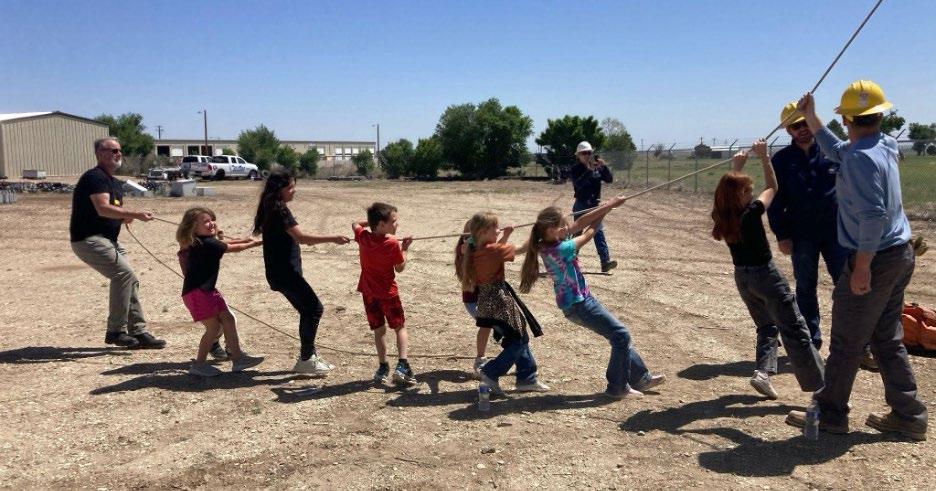
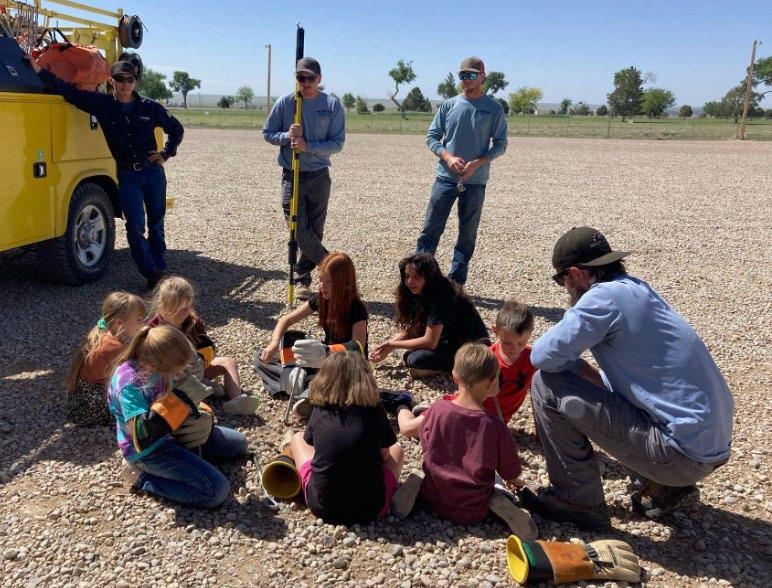
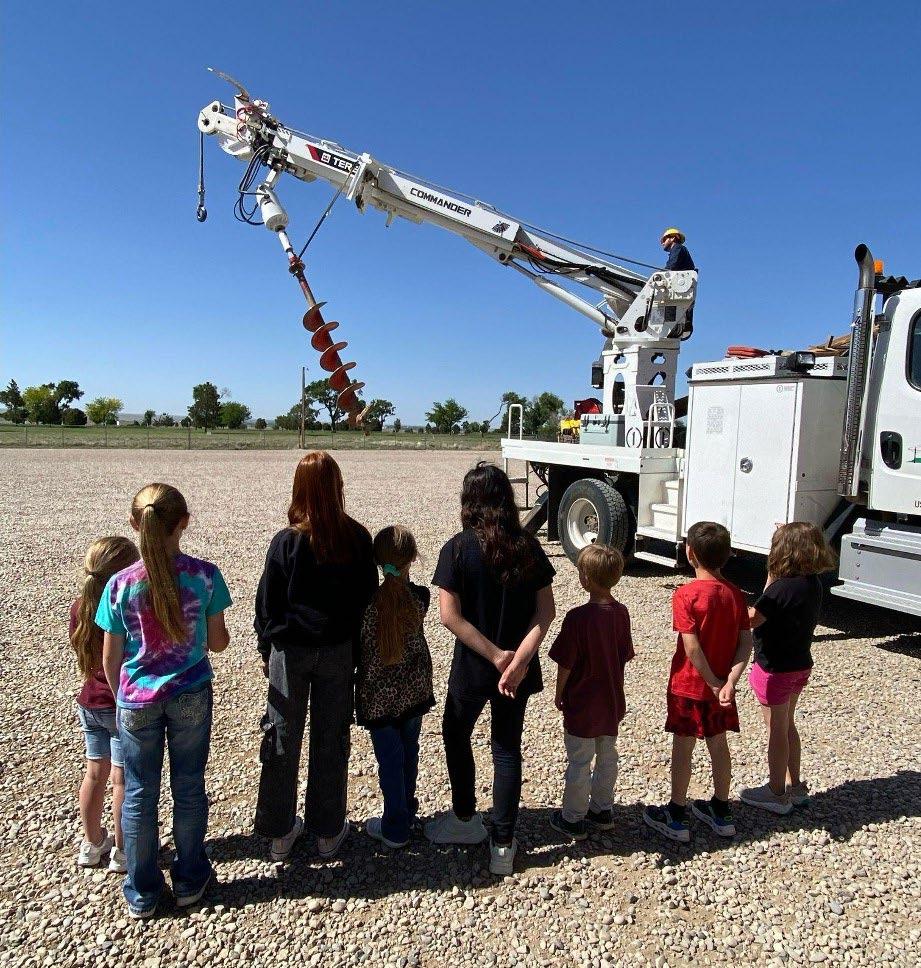

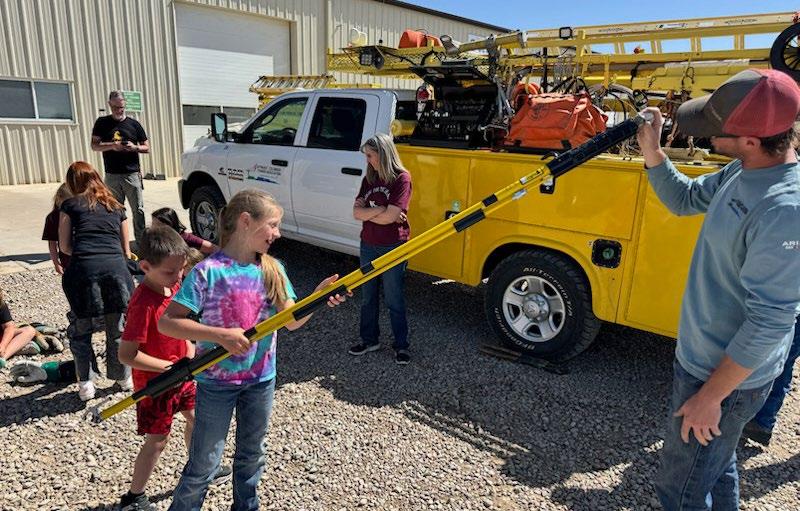

If you are familiar with The New York Times crossword puzzles, you’ll know that they start off on the easier side at the beginning of the week. The puzzles get more difficult each day as the week goes on, until the ultimate challenge: the Sunday puzzle.
I grew up watching my mom solve Sunday puzzles; she grew up watching her grandma solve crossword puzzles, too. It’s with that tidbit of information that you could deduct that I come from a long line of “Word Nerds” (as my husband likes to say).

One thing I look forward to each morning is solving a Times crossword puzzle with my coffee. It has become a simple little ritual, a slow start to the day.
Admittedly, I have never completed a Times Sunday puzzle. I have a small book of Monday and Tuesday puzzles; one takes me about 20 minutes to solve. Though on the easier side, they still challenge my brain to think outside the box, so to speak, to come up with answers to the clever clues.
My team and I have been toying around with the idea of fitting a puzzle into the magazine, and we were able to make it happen in this issue. Turn to page 33 to find it.
We hope you enjoy solving the puzzle. Email me at kcoleman@coloradocountrylife.org and let me know what you think!

STAFF
Cassi Gloe, Publisher cgloe@coloradocountrylife.org
Kylee Coleman, Editor kcoleman@coloradocountrylife.org
Melinda Taylor, Editorial Assistant mtaylor@coloradocountrylife.org
SUBSCRIBERS
Report change of address to your local cooperative. Do not send change of address to Colorado Country Life. Cost of subscription for members of participating electric cooperatives is 30 cents per month, paid from equity accruing to the member. For nonmembers, a subscription is $15 per year in state/$20 out of state.
advertising@coloradocountrylife.org 720-407-0712
National advertising representative: American MainStreet Publications 611 S. Congress St., Suite 504 Austin, TX 78704 | 800-626-1181
Advertising Standards
Publication of an advertisement in Colorado Country Life does not imply endorsement by any Colorado rural electric cooperative or the Colorado Rural Electric Association. Colorado Country Life (USPS 469-400/ISSN 1090-2503) is published monthly by Colorado Rural Electric Association, 5400 Washington St., Denver, CO 80216-1731. Periodical postage paid at Denver, Colorado. ©2025, Colorado Rural Electric Association. Call for reprint rights. View advertising and editorial policy terms and conditions online at coloradocountrylife.coop.
Denver Corporate Office 5400 Washington St. Denver, CO 80216
info@coloradocountrylife.org 303-455-4111
Editorial opinions published in Colorado Country Life magazine shall pertain to issues affecting rural electric cooperatives, rural communities, and citizens. The opinion of CREA is not necessarily that of any particular cooperative or individual.















By Craig Johnson
Fishing with “flies” traces its origins back to the ancient Greeks, who would catch “fish with speckled skins” using hooks dressed with crimson wool and wax-colored feathers from a rooster’s neck. Since these humble beginnings, the art of fly tying has evolved into a hobby all its own.
In the 1800s, explorers filled the museums and zoos of Europe with colorful bird species from around the world, such as the king bird of paradise of Indonesia with its bright red feathers and the resplendent quetzal of Central America. In addition to the scientific world, their brightly colored plumage caught the eye of fly tiers, who used their feathers to create complex and beautiful flies, sometimes incorporating the feathers of more than a dozen different birds in a single fly. Scottish fly tier Jock Scott, for example, tied his namesake fly using the feathers of toucan, macaw, Indian crow, and more. These vintage flies are considered collectors’ items, often selling for hundreds of dollars each — not the kind of investment you want to see destroyed in the maw of a trout or salmon, no matter how nice the catch might be.
While tying ornate flies with exotic feathers was a pastime of the well-to-do in Europe, a distinctly more democratic version of fly tying evolved in the Catskills and Adirondacks of the northeastern United States. These practical flies used drab-colored fur for bodies, feathers tied in an upright position to imitate the wings of a bug, and wraps of hackle to make them float and give an impression of wiggling
legs. These patterns, which predominate today, relied on common materials readily available to the average angler, consistent with the U.S. ideal that fishing is not limited to the aristocracy.
There are now fly patterns for every conceivable bug in every size, shape, and color imaginable. A fly doesn’t have to be a perfect imitation to catch fish. Take the Copper John, a favorite here in the Rocky Mountain region, which consists of a split tail of goose biots (pointy little feathers taken from the leading edge of the wing of a goose), a body of wrapped copper wire, a thorax made of green ostrich herl, a dab of hard epoxy covering a plastic strip on the back to give it some flash, and a shiny bead head. It takes forever to tie and looks more like something you would read about in a sci-fi novel than anything you would find in the natural environment. But the size and shape resemble a little bit of everything and nothing at all, making it irresistible to trout.
There is something special about catching a fish with a fly, especially one you tied yourself; it adds a whole new dimension to the art of fly-fishing. If you want to add a new twist to your fly-fishing experience, take a class or buy a book and try tying a fly of your own. Who knows — you might catch the fish of a lifetime.
Craig Johnson is CREA’s director of policy and strategy/general counsel, and an avid fly-fisher and outdoorsman in his spare time.



Get a $29 Keep Colorado Wild Pass with your next vehicle registration to create sweet summer memories. The pass gives you entry to all state parks and supports wildlife conservation.

Enter to win an outdoor blanket to bring on your stargazing adventures this summer! This blanket has a waterproof outer shell, rolls up for carrying and storage, and is machine washable.
Turn to page 18 for the best places to view the night skies.
To enter the contest, scan this QR code or fill out the form at coloradocountrylife.coop/ ccl-monthly-giveaway
If you need another way to enter our contests, send a letter or postcard with your name, phone number, address, and the name of your electric co-op to 5400 Washington St., Denver, CO 80216.
We will randomly draw one name to win the blanket on July 20.



•
•
•
•





































By Melinda Taylor Editorial Assistant
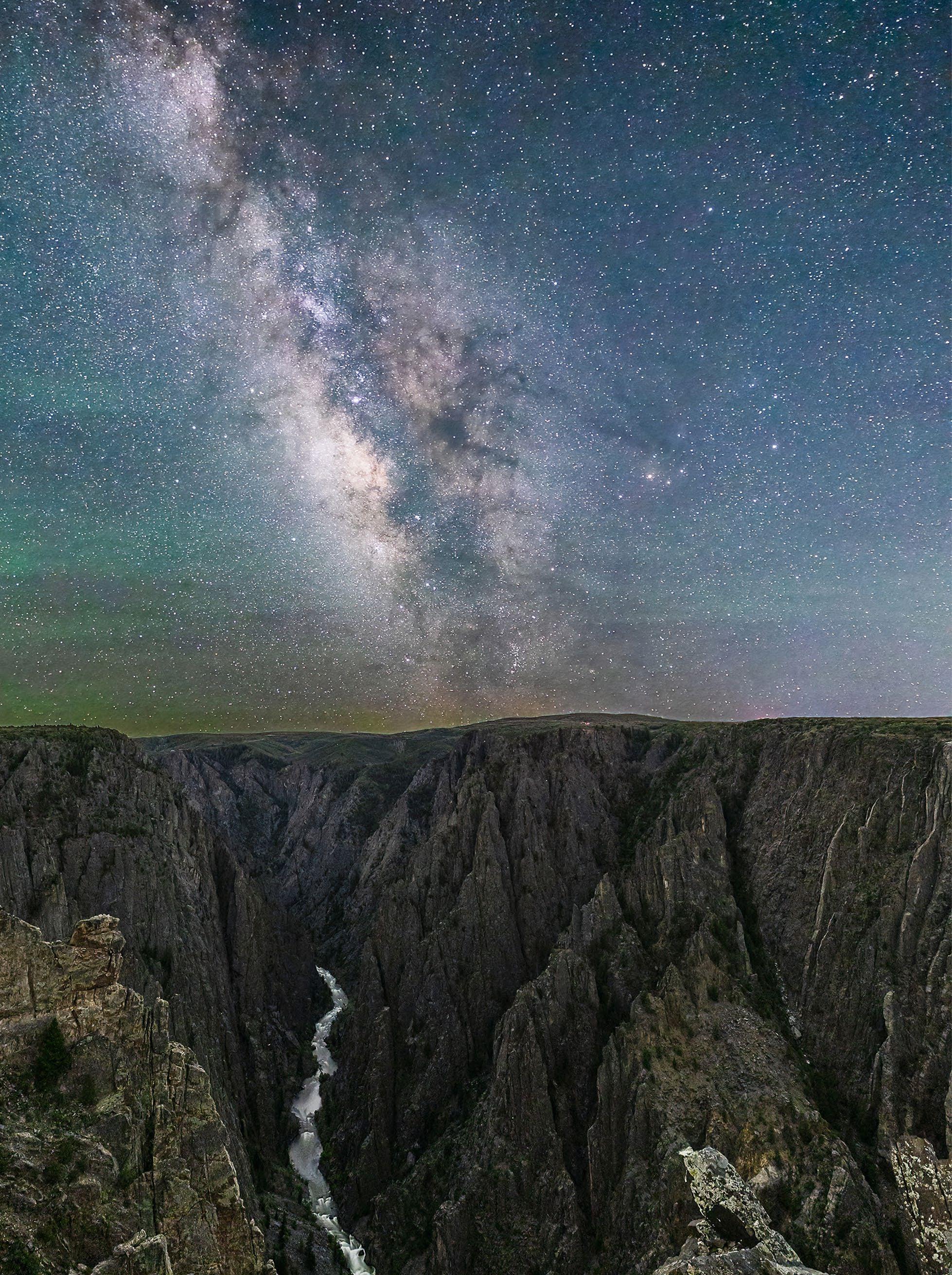
The awe-inspiring Perseid meteor shower will be on display this summer from July 17 through August 23. The very best time for viewing is in the early morning hours before dawn. Sometimes it’s hard to escape the bright lights of cities and towns, but thanks to public support, Colorado boasts 12 certified Dark Sky Parks and six Dark Sky Communities. Almost anyone in Colorado with reliable transportation can access a certified Dark Sky Place within 90 minutes.
According to DarkSky International, a certified Dark Sky Park is “land possessing an exceptional or distinguished quality of starry nights and a nocturnal environment that is specifically protected for its scientific, natural, or educational value, its cultural heritage, and/or public enjoyment.” A Dark Sky Community is a city or town that has shown dedication to night-sky preservation through outdoorlighting ordinances, education, and other efforts.
DarkSky International strives to combat the negative effects of light pollution around the world, protect nocturnal species, and allow astronomers to conduct research. It began in 2001 and has certified more than 200 places on Earth as Dark Sky Places. For more information on DarkSky International, visit darksky.org. For Colorado-specific information, visit darkskycolorado.org.
1. Black Canyon of the Gunnison National Park
2. Browns Canyon National Monument
3. Curecanti National Recreation Area
4. Dinosaur National Monument
5. Florissant Fossil Beds National Monument
6. Great Sand Dunes National Park and Preserve
7. Gunnison Gorge National Conservation Area
8. Hovenweep National Monument
9. Jackson Lake State Park
10. Lake Fork Earth and Sky Center
11. Mesa Verde National Park
12. Top of the Pines
1. Crestone
2. Norwood
3. Nucla and Naturita
4. Paonia
5. Ridgway
6. Westcliffe and Silver Cliff

As we think ahead to the season of shorter days and twinkling lights, we’d like to make space to appreciate the people who bring light into our lives.
Has someone helped you through a hard time by saying a kind word, sharing a warm meal, or just by being there? Maybe it was a friend who made you laugh when you needed it most, a neighbor who stepped in when you were struggling, or a stranger whose simple act of kindness stuck with you.
We’d love to hear your story for our December 2025 issue. Keep it short and heartfelt — we’re looking for the everyday stories that remind us how powerful a little light can be. Content may be edited for space and clarity.
• Deadline: September 20
• Word count: 200–300 words
• Submit by
• Email: editor@coloradocountrylife.org
• Online: coloradocountrylife.coop/light-in-the-dark
• USPS: Colorado Country Life, Attn: Editor, 5400 Washington St., Denver, CO 80216
Let’s shine a little light together.
By Eugene Buchanan
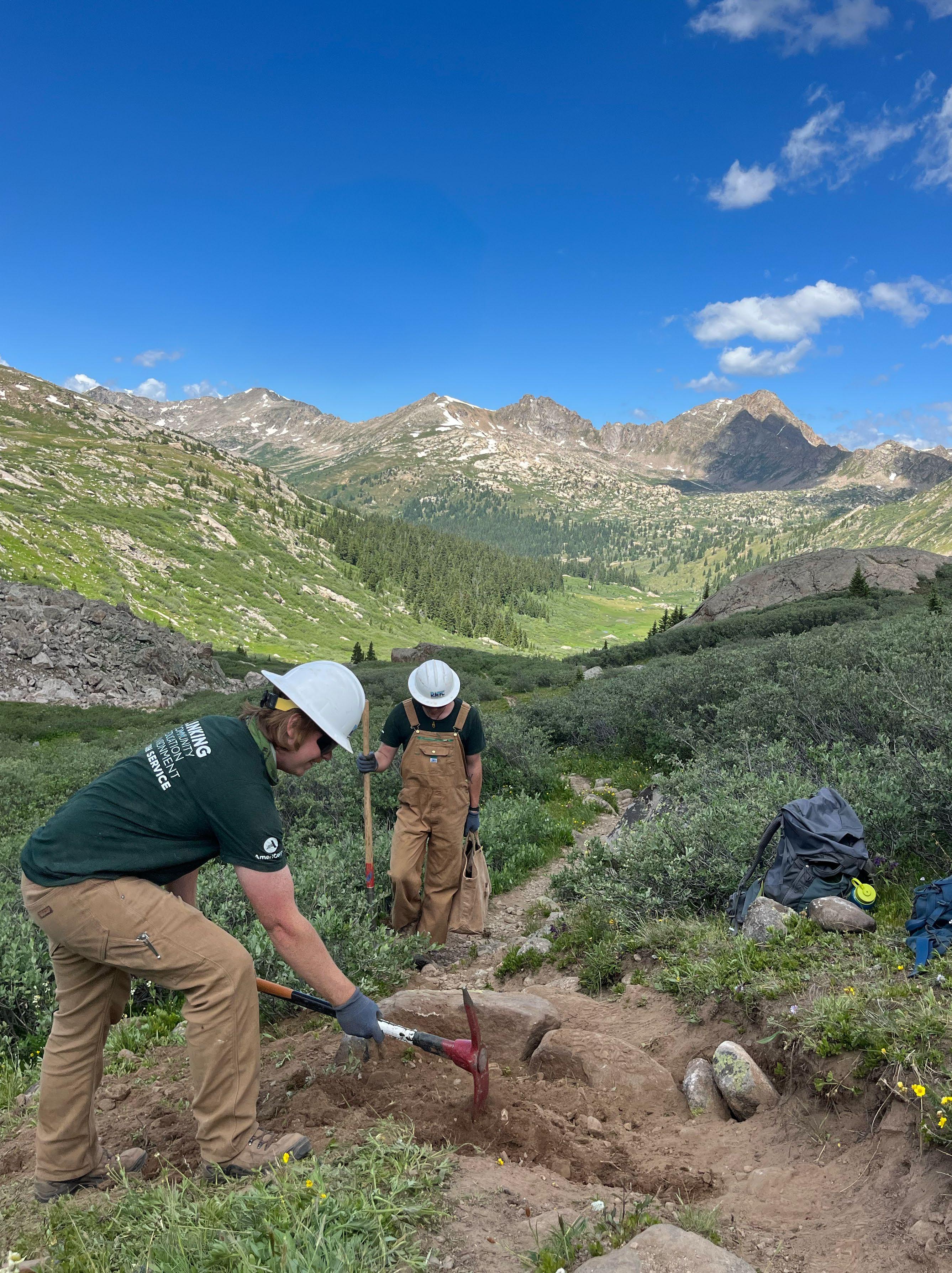
I believe the perfect life means living in a place that inspires you, having a job that is fulfilling, and surrounding yourself with like-minded people. RMYC provides all these opportunities.”
— Loretta McEllhiney, former Colorado Fourteeners Program Manager, USFS
It’s brutal work. I’m at 12,000 feet on an eroded trail on Mount Quandary outside Breckenridge with a team of volunteers, improving the path leading up one of Colorado’s most popular fourteeners. But my shoulders and lower back resent every swing of my Pulaski. Beside us is a Jenga pile of logs that we need to pick up and carry using a vice-like metal claw device and wrestle into position as stair treads. Then we must pulverize rocks with pickaxes to backfill the gaps and secure them in place. Breaking rocks and carrying logs at 12,000 feet ... it’s not a walk in the park.
I’m here as part of a volunteer weekend organized by the Colorado Fourteeners Initiative, bettering the trails for the 300,000 hikers who climb Colorado’s peaks every year and bring $76 million into the state’s economy. Beside me is filmmaker and high-alpine mountaineer Renald Ozturk, as well as crew members from Rocky Mountain Youth Corps, one of eight accredited organizations making up the Colo rado Youth Corps Association. Clamping the device’s metal jaws around a log, we tandem-waddle it into place, tap it down, and begin shoveling.
I can’t say, “This wasn’t in the brochure,” because it is. This is the daily routine for the more than 2,000 conservation service corps crew members in the state who last year improved or maintained 752 miles of trails and mitigated 5,000 acres of wildland fire zones. Celebrating 25 years of engaging youth in the outdoors, the CYCA represents eight corps throughout the state — including Boulder County Youth Corp, Larimer County Conservation Corps, Mile High Youth Corps, Rocky Mountain Youth Corps, Southwest Conservation Corps Four Corners, Southwest Conservation Corps Los Valles, Western Colorado Conservation Corps, and Weld County Youth Conservation Corps. Among other things, these crews work on wildfire fuel mitigation and suppression, trail maintenance, fence construction and removal, invasive species treatment and eradication, energy and water conservation, and historic preservation.
“The awareness of our mission and impact is definitely increasing,” said CYCA Executive Director Scott Segerstrom. “We’re now seen as a critical tool for conser vation and are even being invited to the table for input on policies. Corps are now institutionalized into our partners’ operations and are seen as irreplaceable. Our momentum is growing.”
CYCA also provides its participants with valuable work and life skills, while imparting the importance of public lands. “It’s critical that today’s youth have forma tive experiences that reinforce how valuable our natural resources are,” Segerstrom added. “Experiences in the outdoors lead these young people to be informed voters, engaged conservationists, and confident, resilient people. They learn conflict resolu tion, empathy, communication skills, and more, which prepares them to be positive members of their communities. They not only find their purpose in the corps world — they get to share that purpose with others.”
But as I’m discovering on Mount Quandary, it can also be an uphill battle. Espe cially in the wake of hiring freezes and cuts to public land partners. In fall 2024, the U.S. Forest Service announced it would suspend all seasonal hiring for the 2025 season, cutting about 2,400 jobs — the largest single-year staff cut in recent memory. Add the recent cuts to the National Park Service, Bureau of Land Management, and Forest Service — all of which are youth corps program partners — and the situa tion spirals.
Nearly all the Forest Service’s earlier cuts were field-based jobs, including biolo gists, timber workers, trail technicians, and recreation staff. And the cuts also affect CYCA’s accredited corps affiliates, which put young adults out in the field.

All photos courtesy Rocky Mountain Youth Corps continued on page 22

Putting one foot ahead of the other through all these hurdles is CYCA affiliate Rocky Mountain Youth Corps, based in Steamboat Springs. The Forest Service cuts will likely affect them, as their crews do a lot for the Medicine Bow-Routt and White River national forests.
That said, it’s still shaping up to be a robust year for RMYC. Housed in a 4,300-square-foot building on a 3.4-acre campus in Steamboat Springs, RMYC has served nearly 14,000 youth in its three decades of service, including more than 5,000 through its Yampa Valley Science School program. Its crews work on everything from community cleanups, wildfire mitigation, tree planting projects, trail building, geographic information system programming, historic structure preservation, hydrology and archaeology projects, beetle kill removal, and more. Its burgeoning internship program helps participants pursue land management careers.
Like the clouds RMYC crews deal with in the mountains, all this is a silver lining to the cuts its public lands partners are facing. “We’re strengthening our partnerships with land managers throughout our region and providing meaningful service opportunities to young people," said RMYC Chief Executive Officer Ryan Banks,
who oversees a $7 million operating budget for his crews. “We’re looking forward to another summer helping public land managers complete their conservation projects — especially since now they may be a little shorthanded.”
Banks walks the walk. He spent several years working with AmeriCorps programs before joining RMYC’s full-time staff in 2017 and taking its reins in January 2024 from retiring CEO and founder Gretchen Van de Carr. As with RMYC’s crews, he hit the ground running. Last year, RMYC put more crew members into the field than ever; the corps served more than 850 youth through its various programs, improving 1,621 acres of public lands.
Like the ones joining me on Quandary, RMYC’s crews maintained more than 700 miles of trails and removed or mitigated more than 16,000 trees. Crews are also beefing up their wildfire mitigation efforts, including fielding an all-women’s chain saw and fire mitigation crew. “It’s a pretty male-dominated profession, so whenever we can help increase diversity it’s pretty special,” said Medicine Bow-Routt National Forest Fire Management Officer Chris Green.
Fourteeners are a staple recipient of the corps’ efforts. The Colorado Fourteeners Initiative was formed in 1994 as a partnership of nonprofits, private donors, and public agencies to preserve and protect Colorado’s 58 fourteeners. And they regularly tap corps crews like those from RMYC for their projects. Another fourteener on the receiving end of their tenderloving shovels is Mount Elbert, Colorado’s highest peak at 14,439 feet. Crews from RMYC have spent the last few years giving its stairway to the sky a little love. “The workdays are pretty intense,” said Banks, who’s worked on several fourteeners himself. “You’re up before dawn and need to be off the mountain by 2 p.m. when the storms roll in. But it has a cult-like vibe; people want to work there. Elbert is an iconic peak, and you’re building something that will be there for 100 years.”
Putting in 10-hour days and hiking 3,000 vertical feet each morning from base camp up to 13,500 feet, RMYC crews worked on the peak’s North Elbert and Black Cloud trails, using timber features as treads. Higher on the peak, they used rocks to construct walls and staircases using a grip hoist to haul the stones up to the project site. Over the course of an eightday hitch, or typical work session, a crew would work two days on the lower site to acclimate and then six days higher up.
“RMYC is a longtime partner of ours and an integral part of making our projects happen — especially with our work on Elbert,” said former CFI Field Programs Director Ben Hanus. “It’s a strenuous place to work, but we’re grateful for the help. [RMYC crews] come with training, crew leaders, and great attitudes. Next to CFI staff, they’re the next best qualified to do this type of work.” He’s also glad for the experience it gives the kids. “It lets us introduce trail work to youth who otherwise might not get the experience, while also creating more future stewards of fourteeners.”
Leadville’s Loretta McEllhiney, former Colorado Fourteeners Program Manager for the USFS, has seen firsthand the positive impact corps crews have on Colorado’s natural resources and youth. For her, there is nothing better than helping youth find their calling outdoors. “RMYC provides much of the labor necessary to complete these backbreaking projects,” she said. “These crews help build respect for the natural environment, develop job skills, teach the meaning of service, and provide an opportunity to work in a team environment. The perfect life means living in a place that inspires you, having a fulfilling job, and surrounding yourself with likeminded people. Youth corps provide all these opportunities.”
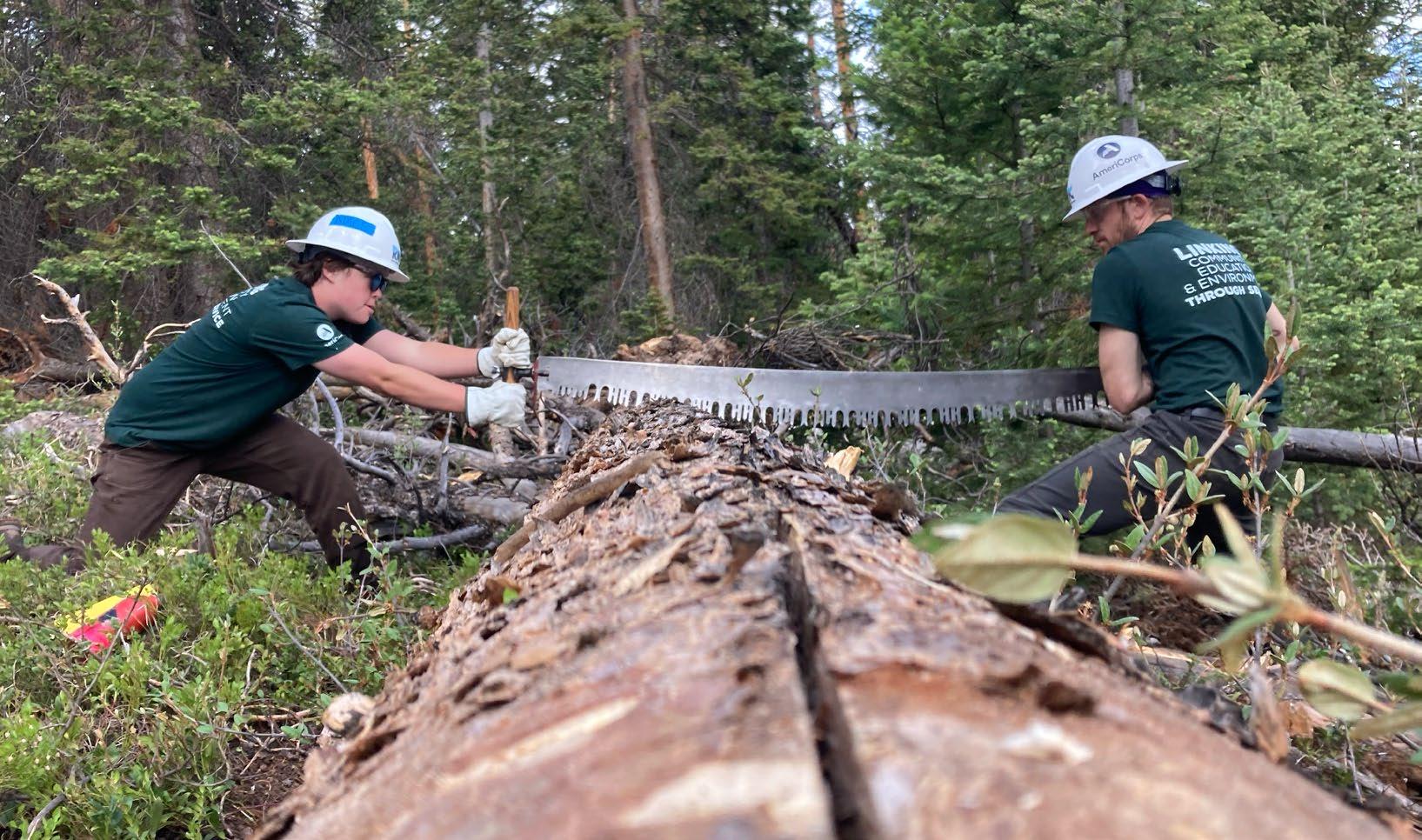

What is a Fourteener?
fȯr-ˈtē-nər\ noun
A mountain with an elevation of at least 14,000 feet.
continued on page 24
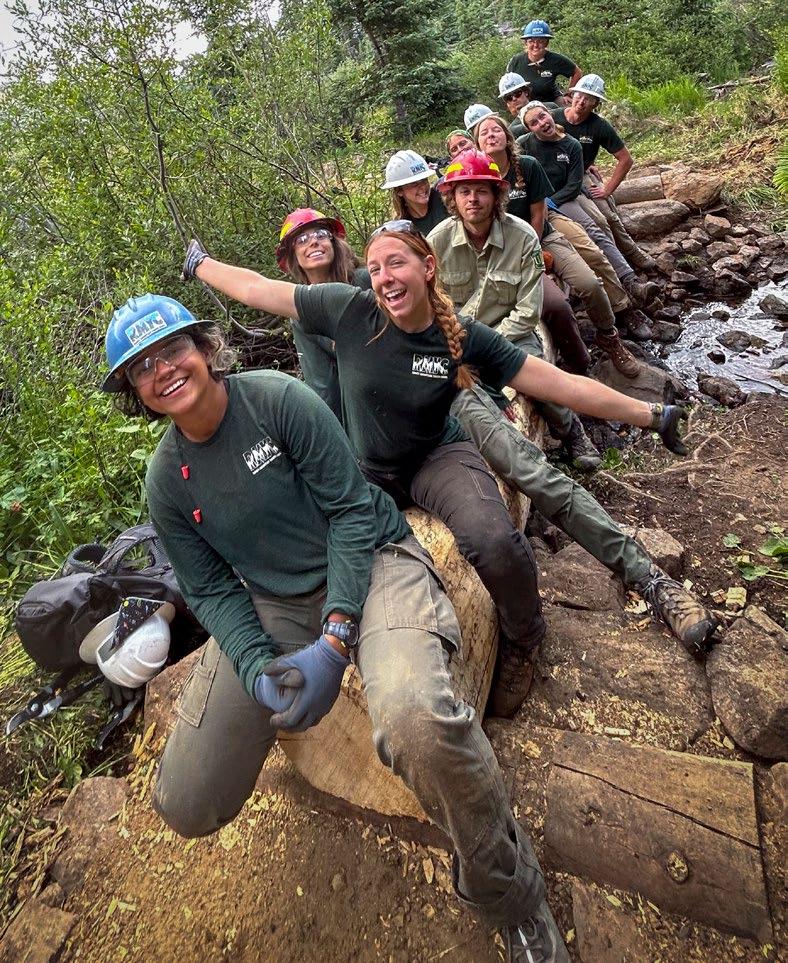
Maintaining trails includes extracting huge boulders. Last year, more than 2,000 conservation service corps crew members improved or maintained 752 miles of trails and mitigated 5,000 acres of wildland fire zones across Colorado.

Combine RMYC’s work with that of the state’s other youth corps and, like the trails they maintain, things are going nowhere but up. CYCA is coming off its biggest year ever. “Investment in the corps has tripled in the past three years, from $3 million annually to more than $10 million,” said Segerstrom, who is working with project partners to keep investing in the state’s eight associations and is maintaining corps relations with such entities as the Great Outdoors Colorado lottery trust, the Bureau of Land Management, Colorado Parks and Wildlife, and more.
The 2018 recipient of the Governor’s Service Award for Outstanding Community Leadership, Segerstrom is a former wilderness ranger and wildland firefighter with the U.S. Forest Service who got his start with RMYC. He spent several years leading RMYC’s chain saw and Continental Divide Trail crews, worked on a fourteener high-altitude trail and archaeology crew, and
eventually became the director of RMYC’s conservation corps program. Now at CYCA he manages and disperses the two largest AmeriCorps grants in Colorado and supports a corps sector that has grown to a collective operating budget of $28 million in the state.
All this is good news for CYCA’s eight accredited conservation corps like RMYC, who are eager to pitch in and help. “The cutbacks our partner organizations are facing are definitely unfortunate, but we look forward to picking up whatever slack we can with our land management agencies by continuing to offer meaningful outdoor service opportunities to our crew members,” Banks said. “It’s a win-win for everyone.”
Eugene Buchanan is a former reporter for the Denver Business Journal and 14-year publisher and editor in chief of Paddler magazine. His freelance articles have been published in The New York Times, Men’s Journal, Outside, National Geographic Adventure, Forbes Life, and more. He lives in Steamboat Springs.
Half a mile beneath the icy waters off the coast of Argentina lives one of the most remarkable creatures in the world.
Fully grown, they’re less than 2 feet long and weigh under 10 pounds…
But despite their small size, this strange little squid can have a bigger positive impact on your brain health than any other species on the planet.
They are the single richest source of a vital “brain food” that 250 million Americans are starving for, according to a study published in the British Medical Journal.
It’s a safe, natural compound called DHA – one of the building blocks of your brain. It helps children grow their brains significantly bigger during development. And in adults, it protects brain cells from dying as they get older.
Because DHA is so important, lacking enough of it is not only dangerous to your overall health but could be directly related to your brain shrinking with age. With more than 16 million Americans suffering from ageassociated cognitive impairment, it’s clear to a top US doctor that’s where the problem lies.
Regenerative medicine specialist Dr. Al Sears, says thankfully, “there’s still hope for seniors. Getting more of this vital brain food can make a life changing difference for your mental clarity, focus, and memory.”
Dr. Sears, a highly-acclaimed, board-certified doctor— who has published more than 500 studies and written 4 bestselling books — says we should be able to get enough DHA in our diets… but we don’t anymore.
“For thousands of years, fish were a great natural source of DHA. But due to industrial fish farming practices, the fish we eat and the fish oils you see at the store are no longer as nutrientdense as they once were,” he explains.
DHA is backed by hundreds of studies for supporting razor sharp focus, extraordinary mental clarity, and a lightning quick memory… especially in seniors.
So, if you’re struggling with focus, mental clarity, or memory as you get older…
Dr. Sears recommends a different approach.
Research has shown that our paleo ancestors were able to grow bigger and smarter brains by eating foods rich in one ingredient — DHA.
“Our hippocampus thrives off DHA and grows because of it,” explains Dr. Sears. “Without DHA, our brains would shrink, and our memories would quickly fade.”
A groundbreaking study from the University of Alberta confirmed this. Animals given a diet rich in DHA saw a 29% boost in their hippocampus — the part of the brain responsible for learning and memory. As a result, these animals became smarter.
Another study on more than 1,500 seniors found that those whose brains were deficient in DHA had significantly smaller brains — a characteristic of accelerated aging and weakened memory.
Dr. Sears uncovered that sometime during the 1990s, fish farmers stopped giving their animals a natural, DHA-rich diet and began feeding them a diet that was 70% vegetarian.
“It became expensive for farmers to feed fish what they’d eat in the wild,” explains Dr. Sears. “But in order to produce DHA, fish need to eat a natural, marine diet, like the one they’d eat in the wild.”
“Since fish farmers are depriving these animals of their natural diet, DHA is almost nonexistent in the oils they produce.”
“And since more than 80% of fish oil comes from farms, it’s no wonder the country is experiencing a memory crisis. Most people’s brains are shrinking and they don’t even know it.”
So, what can people do to improve their memory and brain function in the most effective way possible?

MEMORY-RESTORING SENSATION: The memory-saving oil in this Antarctic squid restores decades of lost brain power starting in just 24 hours.
Dr. Sears says, “Find a quality DHA supplement that doesn’t come from a farmed source. That will protect your brain cells and the functions they serve well into old age.”
Dr. Sears and his team worked tirelessly for over 2 years developing a unique brainboosting formula called Omega Rejuvenol
It’s made from the most powerful source of DHA in the ocean, squid and krill — two species that cannot be farmed.
According to Dr. Sears, these are the purest and most potent sources of DHA in the world, because they haven’t been tampered with. “Omega Rejuvenol is sourced from the most sustainable fishery in Antarctica. You won’t find this oil in any stores.”
Already, the formula has sold more than 850,000 bottles. And for a good reason, too. Satisfied customers can’t stop raving about the memory-boosting benefits of quality-sourced DHA oil.
“The first time I took it, I was amazed. The brain fog I struggled with for years was gone within 24 hours. The next day, I woke up with the energy and mental clarity of a new man,” says Owen R.
“I remember what it was like before I started taking Omega Rejuvenol… the lack of focus… the dull moods… the slippery memory… but now my mind is as clear as it’s ever been,” says Estelle H.
“My mood and focus are at an all-time high. I’ve always had trouble concentrating, and now I think I know why,” raves Bernice J.“The difference that Omega Rejuvenol makes couldn’t be more noticeable.”
And 70-year-old Mark K. says, “My focus and memory are back to age-30 levels.”
These are just a handful of the thousands of reviews Dr. Sears regularly receives thanks to his breakthrough memory formula, Omega Rejuvenol
WHERE TO FIND OMEGA REJUVENOL
To secure bottles of this brainbooster, buyers should contact the Sears Health Hotline at 1-888-358-8247. “It takes time to manufacture these bottles,” says Dr. Sears. “The Hotline allows us to ship the product directly to customers who need it most.”
Dr. Sears feels so strongly about this product, he is offering a 100%, money-back guarantee on every order. “Send back any used or unused bottles within 90 days and I’ll rush you a refund,” says Dr. Sears.
The Hotline is taking orders for the next 48 hours. After that, the phone number may be shut down to allow for inventory restocking. Call 1-888-358-8247 to secure your limited supply of Omega Rejuvenol. Readers of this publication immediately qualify for a steep discount, but supplies are limited. To take advantage of this great offer use Promo Code COOM725 when you call.
By Miranda Boutelle

Q: How do I improve the efficiency of my older home while keeping its charm?
A: The features of older homes can make them less efficient than modern construction, but it doesn’t have to be that way. There are ways to keep charm while increasing efficiency.
Start by prioritizing the invisible upgrades that make your home more comfortable and efficient. When we were kids, I don’t think any of us thought, “When I grow up, I want to spend my hard-earned money on insulation.” It’s not as exciting as new countertops or a remodeled bathroom, but air sealing and insulation can save you money every month.
Many older homes are not properly insulated. Insulation has several benefits beyond sealing your home and keeping outdoor air from seeping in. It reduces outdoor noise, makes your home quieter, and improves your overall comfort.
Always properly air seal before you insulate. Older homes with pocket doors, coved ceilings, dumbwaiters, doors to attic spaces, and laundry chutes allow indoor air to escape through the cavities, gaps, and cracks around these classic features. Sealing off open cavities around those features often requires plywood, rigid foam, or drywall fastened into place and then caulked around the edges.
Dense-packed cellulose or closed-cell foam insulation can be sprayed into exterior walls. Skilled contractors can remove pieces of siding and drill holes to fill the wall cavities from the outside of the home. For brick or stone homes, holes can be drilled from the inside and then patched and painted. Insulating walls from the inside of the home requires more time and effort in preparation and cleanup, but having well-insulated walls is worth it.
For safety purposes, knob and tube wiring — commonly used from the early 1880s to the 1930s with no grounding wire — should be replaced before insulating walls and attics. Contact between insulation and knob and tube wiring can create a fire hazard.
Older homes don’t have to be inefficient. Show your home some love and invest in energy efficient upgrades.
Miranda Boutelle is the chief operating officer at Efficiency Services Group in Oregon, a cooperatively owned energy efficiency company. She has more than 20 years of experience helping people save energy at home.









































A summer potluck is a fun and easy way to gather with friends in your backyard without having to do all the food prep yourself. This month we collaborated with electric co-op employees from across Colorado for a virtual side dish recipe swap. These tried-and-true recipes will get you started at your own backyard party or help you decide what to bring to your next cookout.

By Alliy Sahagun Gunnison County Electric Association

Ingredients
3 lb round red potatoes, cut into 1" pieces
1 small red onion, cut into wedges, 1/2 cup
6 cloves garlic, minced
2 tbsp olive oil
• 1 cup frozen whole kernel corn
Dressing
3/4 cup mayonnaise
• 2 tbsp cider vinegar
• 1 oz envelope dry ranch salad dressing mix
• 1/4 tsp cayenne pepper, optional
• 1/2 cup celery, sliced on the bias
• 3 hard-cooked eggs, peeled and chopped
• 1 avocado, halved, seeded, peeled, and chopped, optional
Salt, to taste
• Ground black pepper, to taste
• 1 bunch Italian flat leaf parsley, coarsely snipped, optional
Instructions
Preheat oven to 425 degrees.
Serves 12
Place potatoes, onion, and garlic on a 15" x 10" baking pan. Drizzle vegetables with the olive oil and toss to coat. Roast uncovered for 20 minutes. Stir vegetables and add corn. Roast for 15 to 20 minutes longer, or until vegetables are tender and brown.
For dressing, in large bowl whisk together mayonnaise, vinegar, salad dressing mix, and, if desired, cayenne pepper.
Add roasted vegetables and toss to coat. Stir in celery, eggs, and avocado. Season to taste with salt and black pepper.
Transfer to a serving dish. If desired, sprinkle with parsley.
Serve warm or chilled.




Anne Boswell Southeast Colorado Power Association
Ingredients
1 lb bacon | grits | 5 tbsp butter | 2 eggs | 1 to 2 cups shredded ch
Instructions
• Cook the bacon to your desired level of crispiness. Roughly chop the cooked bacon and set aside.
• Prepare 1 1/2 cups of grits according to the package instructions. Salt and pep per to taste.
• Once the grits are cooked, stir in the butter and melt.
• After the grits are slightly cooled, whisk the eggs into the grits.
• Lightly spray a large casserole dish with cooking spray. Pour the grits into the dish and sprinkle the cheddar cheese and bacon on top
• Bake at 350 degrees for approximately 25 minutes.

By Avery Parson Mountain View Electric Association
Ingredients
• 1 box (12 oz) tricolor rotini pasta
• 1 packet Italian salad dressing mix
• ¼ cup white vinegar
• ½ cup olive oil 10 oz cherry tomatoes, halved
• 8 oz mozzarella pearls
• 6 1/2 oz can sliced black olives, drained
• ½ red onion, diced
• 1 cucumber, peeled and chopped
By Rita Sanders Grand Valley Power
Slaw
2 bags angel hair cabbage/slaw
• Roasted peanuts (not dry roasted), to taste
Dried cranberries, to taste
• 1 large red onion, diced
• 1 bunch cilantro, chopped
Instructions
Mix slaw ingredients in a large bowl. In a separate bowl, whisk together all dress ing ingredients until combined. Pour the dressing over the slaw before serving. Serves 12
Instructions
Cook the pasta according to package instructions until al dente (about 6
While the pasta cooks, prepare the Italian dressing by mixing the packet with white vinegar, olive oil, and water as directed.
Drain and rinse the pasta under cold water, then transfer it to a large mixing bowl.
Add the cherry tomatoes, mozzarella pearls, black olives, diced red onion, and cucumber. Pour the prepared Italian dressing over the salad and mix well
Refrigerate for at least 2 hours or overnight to enhance flavors. Serve chille
1 tbsp chili oil or Mongolian fire oil
• 1 hefty pinch red pepper flakes
• Pinch of salt
• Cracked black pepper, to taste
• 1/3 cup rice vinegar
• 2 tbsp sesame oil
• 1/2 cup mayo



By Becky Jensen

Prepare to slow down and watch for wildlife — including bighorn sheep on rocky cliffs and bold kayakers in the whitewater — as you drive State Highway 14 through Poudre Canyon northwest of Fort Collins. Summer is a great time to experience everything this 40-mile canyon and the Cache la Poudre River have to offer.
Consider a getaway to this special landscape in the heart of Poudre Valley REA’s gorgeous service territory.
Hiking opportunities abound in Poudre Canyon. Popular trails in the lower canyon near Fort Collins include sprawling Hewlett Gulch and the more challenging Greyrock Mountain
To avoid crowds and summer heat, head west to the upper canyon, where you can quickly gain access to the cool alpine and stunning wildflowers on Montgomery Pass Trail


Whether you’re a music lover or simply out for a Sunday drive, be sure to stop at Mishawaka Amphitheatre, the legendary music venue, restaurant, and bar built in 1916. You can’t beat the eats served up at the Mish — a local favorite — especially when paired with a cold beverage on the riverfront deck. Better yet, join the Mish for what it does best: a live concert under the stars. View their summer lineup at themishawaka.com
Experienced rafters and kayakers flock to Poudre Canyon for its world-class whitewater. Regardless of your skill level, you can enjoy unforgettable Class II, III, and IV whitewater rafting, or take kayaking lessons with the licensed guides at Rocky Mountain Adventures out of Fort Collins. Book your trip at shopRMA.com
Poudre Canyon boasts multiple campgrounds in Arapaho and Roosevelt National Forests and offers dispersed camping along select roads. If you want a more comfortable base camp, book a tiny home, cozy cabin, or luxury glamping tent at Riverside Colorado, an inviting new canyon resort, located three miles downstream from the Mishawaka. Find more at riversidecolorado.com.
by Becky Jensen


Ten minutes. That’s not a lot of time, but at Colorado’s elevation, that’s all it takes for some people to get a severe sunburn. July is UV Safety Awareness Month and a great time to remember the risks of unprotected sun exposure. Playing it safe in the sun is important for everyone this month and year-round. Regardless of the duration, unprotected sun exposure can have short-term and lasting effects.
Sunburns can make your skin feel hot, tender to the touch, and tight. Immediate symptoms of a sunburn are usually temporary, but over the long term, repeated sunburns can increase your skin cancer risk and lead to leathery skin, dark spots, and wrinkles. Just one blistering sunburn in childhood can double your chances of developing deadly melanoma later in life.
Ten minutes is all it takes to get a sunburn. Take five minutes before your fun in the sun to apply sunscreen and avoid the burn altogether.
Vacations, summer sports, pool time, and backyard barbecues are all signs of a fun summer. Don’t let a sunburn ruin it. Always practice sunsafe strategies no matter the length of exposure.
Seek shade as often as you can, especially between 10 a.m. and 4 p.m. when the UV index is at its highest.
Wear protective clothing: wide-brim hats, UV blocking sunglasses, and SPF rated long-sleeved shirts and pants.
Apply broad-spectrum sunscreen. Use SPF 30 or higher and reapply every two hours. Reapply more frequently if you are in the water or sweating a lot.
Use extra caution near water, sand, and concrete. Reflective surfaces can increase UV intensity and exposure.
The sun’s rays can go through windows, clouds, and light clothing. Daily sunscreen can reduce your risk of UV exposure accumulation.
ACROSS
1. Fad or frenzy
5. Opportunity, so to speak
9. Infiltrator, perhaps
14. Traveling, say
15. Spoonbills do it
16. Pillow filler
17. Juniors, e.g.
19. Fractious
20. Lumberjack’s cry
21. Big beef piece
23. Border duty
25. What tellers do
30. Advent
32. Like a span of oxen
33. “The Water Diviner” actor
36. Redressing
38. Communal pronoun
39. Farmhand, at times
40. Call, in Vegas
41. Broadway handouts
44. Updates a blog
46. Get another magazine
47. Weapon for a trooper
49. Frees from doubt
51. Extreme cruelty
54. Checklist bit
56. High beam? 58. Sousaphones
62. Strip of leaves 64. Word with secret or press
65. “So be it!”
66. Trap starter
67. Frat letter
68. Indicates yes
69. Grown grigs
1. Go on a tirade
2. Expect anon
3. Type of radiation
4. Something to tweeze
5. Overshadows
6. High-quality table wood
7. Coleridge works
8. Pine secretion
9. Became exhausted, with “out”
10. Be a bad witness
11. Campaign creations
12. Trawler attachment
13. Venture
18. Paris flower
22. Library gizmo
24. Savage
26. ___ of hope
27. Out of whack
28. Church dogma
29. A sphere lacks them
31. Breaks the news
33. Coconut product
34. Recreation center posting
35. Grad school grillings
37. Western Colorado sights
39. Bathroom cleaner?
42. “___ don’t say!”
43. Latte preparer
44. Bicycle
45. Hole in the head
48. Empire builders
50. Chair or car style
52. In need of freshening
53. Mercury, for example
55. Office comm.
57. Pilates count
58. Body image, briefly?
59. “Yuck” cousin
60. Quilting social
61. Carpenter at the picnic?
63. Served dinner
© Lovatts Puzzles
Answers on page 34.














• January Nonalcoholic whiskey: Barbara Humbracht, EEA
• February Sushi supplies: Patrice Diem, PVREA
• March Bird book: Karen Dobos, GVP
• April Kid crafts: Barbara Humbracht, EEA
• May Ice cream bowls: Whitni Moebius, GVP










This spring, Colorado Country Life readers responded with generosity to a call for support, and that support is making a real difference. Your donations are bringing a fresh start to families and homes across Navajo Nation.
Ten volunteer linecrews from eight Colorado electric co-ops are participating in Light Up Navajo VI this summer. Each crew spends one week connecting homes that have never had power. Light Up Navajo is a mutual aid initiative of the American Public Power Association and the Navajo Tribal Utility Authority.
Readers helped raise $3,800, which is going directly toward buying a refrigerator for each home Colorado crews help electrify. Your generous donations are offering families safe food storage and a life-changing upgrade in daily living.
Four Colorado electric co-op linecrews have traveled to Navajo Nation to electrify homes, with five more scheduled to go this month. We will share more updates once the trucks roll home.
Thank you for your generous support.
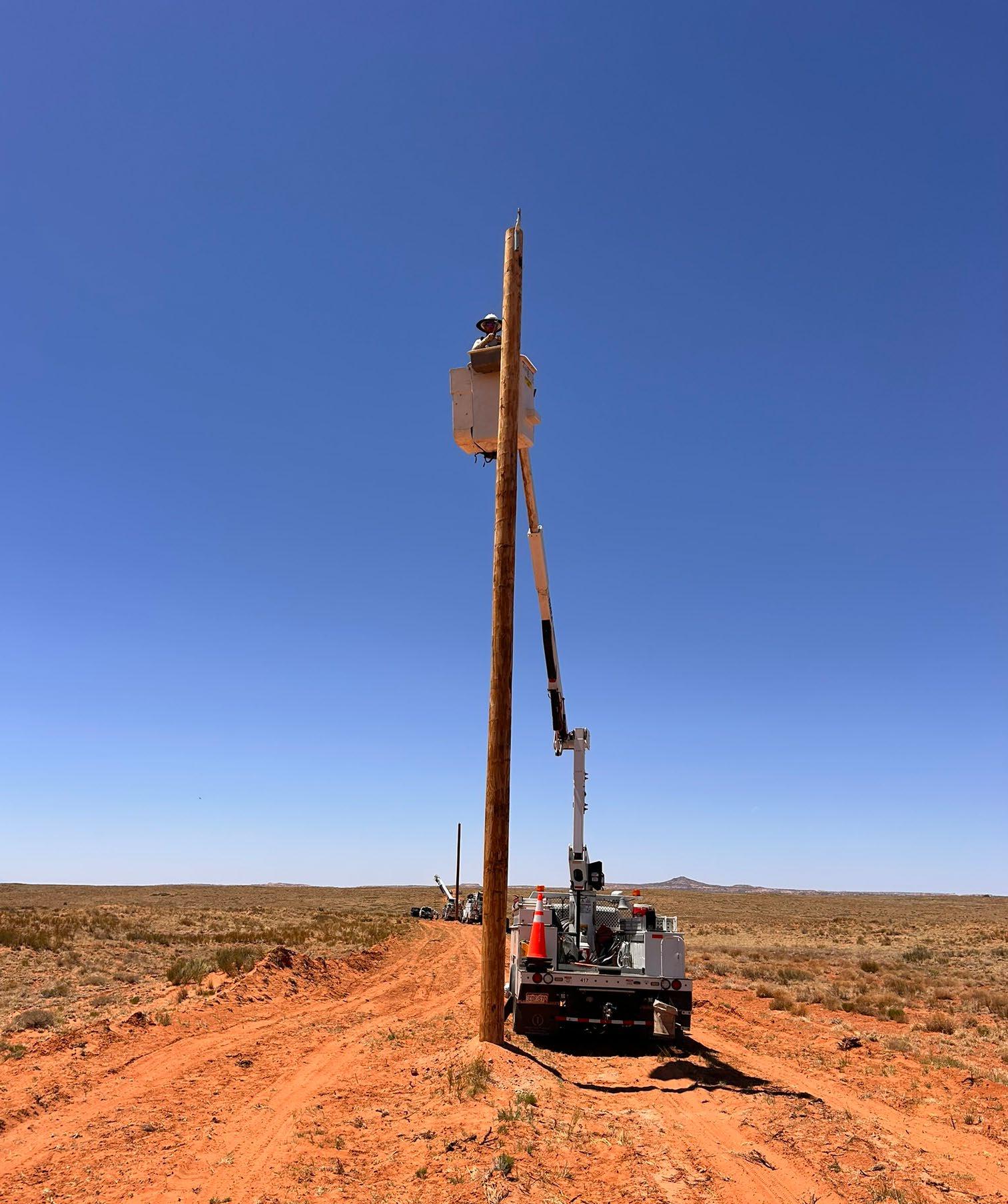
Your next customer is just a page away.
Advertise in Colorado Country Life and get your business in front of 175,000+ engaged readers across Colorado every month.
We’ve got print and digital options to fit your goals and your budget.
Let’s chat about what’s possible.
Email us at advertising@ coloradocountrylife.org.

Picture YOUR BRAND here!


By Gaylene Garcia Granger
One of the best things about summer in Colorado is the abundance of tasty goods found at local farmers markets in cities and towns across the state. Unlike the outdoor markets of old, which mainly featured homegrown produce and meat, today you can meander throughout almost any local farmers market and find arts and crafts by local artisans, specialty food products, home brews, and live entertainment. Here are a few Colorado markets that are sure to fill your basket and your day with joy.

Cortez Farmers Market in beautiful Montezuma County claims to be the oldest market in the state of Colorado, founded in 1973 by Cortez native Bessie White. Her daughter, Cheryl Floyd, still works a produce stand selling her mom’s famous jams and jellies. Word is that the chokecherry is the best.
The market is held at a new location at 601 N. Mildred St. There are 48 vendors who sell fresh produce, coffee, honey, and beef, bison, and yak meat. It’s a market rich in history with plenty of room for the new and trendy. One vendor, Jewelry by Haley, is only 13 years old, but she is a town favorite with her colorful beaded jewelry and art. In September, the Cortez Farmers Market will host a community outreach bike rodeo with local police officers, who will give out 50 bike helmets to local kids.
Visit the market on Saturdays through October 25. Find more information online at cortezfarmersmarket.com.
The Market on Main in Grand Junction is a must visit on your summertime travels. The event typically attracts 5,000 visitors per week with over 100 vendors, 17 of which are local farmers from the Grand Valley. These numbers typically peak in late July when Palisade peaches are widely available on the Western Slope. At the market, you’ll find food vendors, local butchers, bakers, and artists. They are all on Main Street between Third and Seventh streets. According to David Goe, community engagement manager, “We host themed nights and have entertainment past sundown. We also team up with local downtown businesses for special activities like the 600 Block Party.” Market on Main is on Thursday evenings from July 10 through September 25. Find more information online at downtowngj.org/events/market-on-main.
Fort Collins Farmers Market is all about Colorado grown. All vendors grow their own produce, raise their own animals, or craft and package their own food. According to Marketing Director Katie Krull, “The market is great, they always have friendly vendors who work hard to produce different things that go with the seasons. For example, Sweet European Treats will use fresh produce from the market and make unique desserts with them.”
The Fort Collins Farmers Market can be found at 1001 E. Harmony Rd. and runs rain or shine on Sundays through November 9 and Wednesdays through September 24. For more information, visit fortcollinsfarmersmarket.org.
The Woodland Park Farmers Market started in 1990 when the original founders recognized that there were not a lot of options for fresh produce due to the average 8,500-foot elevation of Woodland Park and the surrounding small towns. Today, they’re keeping their cool and selling their goods at Memorial Park, with a stunning backdrop of snow-capped Pike’s Peak in the distance.
Here, customers will find a wide variety of cottage kitchen bakers and producers, fresh eggs, domestic and imported cheeses, in-season produce, local coffee roasters, food trucks, and Colorado beef, yak, and pork, plus local musicians providing entertainment. It retains one of its original six vendors, La Baguette, and has also developed a young entrepreneur program to host young people ages 8-18, to sell their handmade foods and crafts.
The market has received many awards over the years, from being voted one of the top farmers markets in the nation, to a multiyear/multicategory winner for being the best place to meet locals, the best place to hear live music, best outdoor event, and best place to cool off during the summer. The market begins the first Friday in June and runs through the last Friday of September. For directions, visit wpfarmersmarket.com



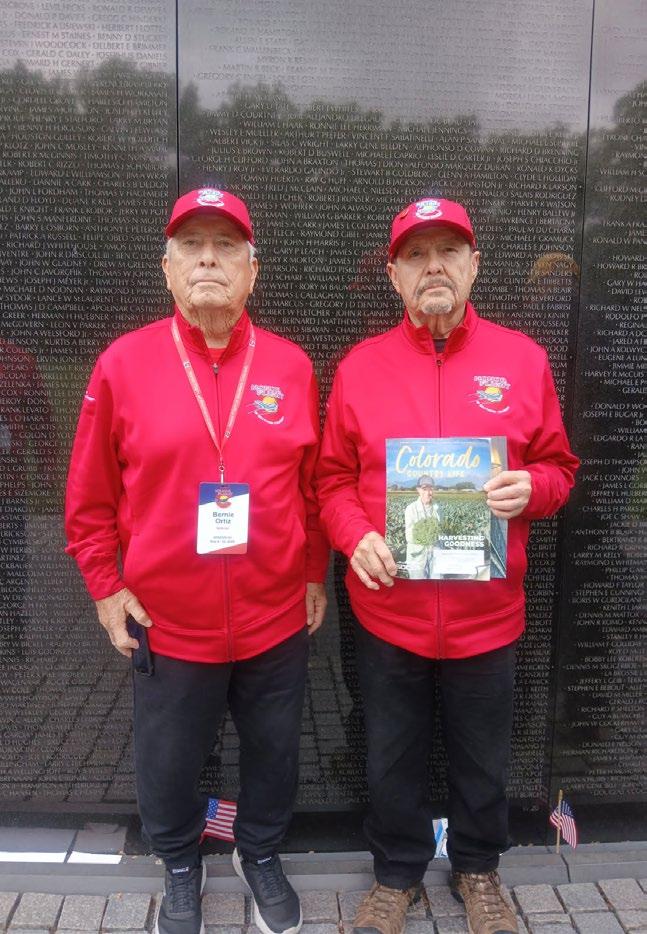
San Isabel Electric Association member Herman Arellano (right) and brother-inlaw Bernie Ortiz travel to Washington, D.C., on Honor Flight #20 recognizing them for their service in the Korean and Vietnam wars. We at CCL thank you for your service and for bringing the magazine on this important trip.
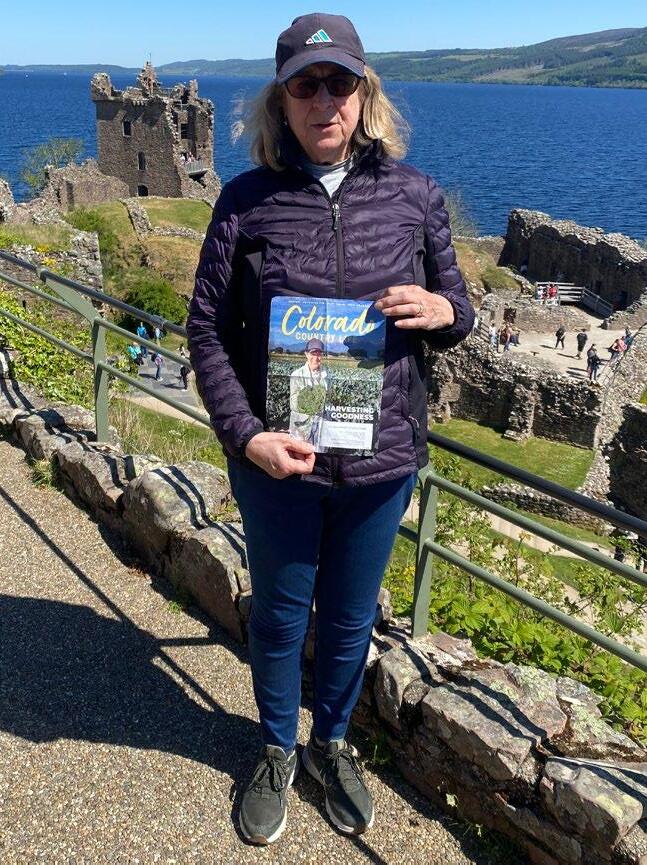
Jan Hopp, a Sangre de Cristo Electric Association member, visits the remains of the Urquhart Castle in Scotland with her copy of CCL.
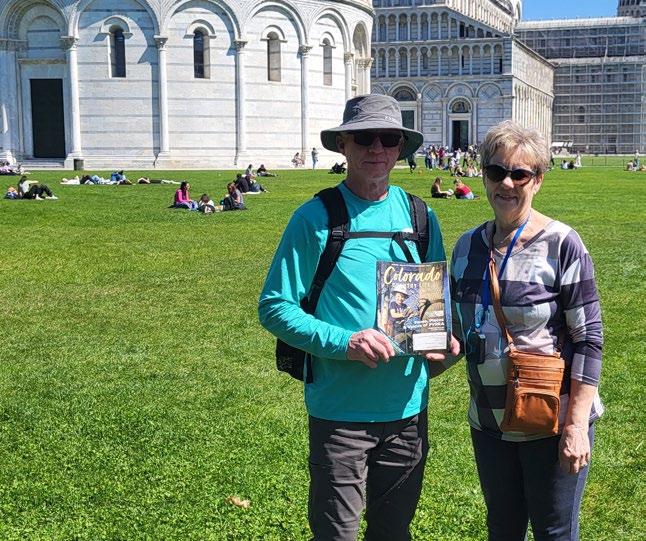
Ron and Joy Harper enjoy the Tuscan countryside and historical Italian sites, including the Leaning Tower of Pisa. The Harpers are members of Poudre Valley REA.

Mountain View Electric members Curtis and Kim Crews bring their copy of the magazine on their trip to Kauai, Hawaii, to celebrate their 27th anniversary with the turtles on Poipu Beach.
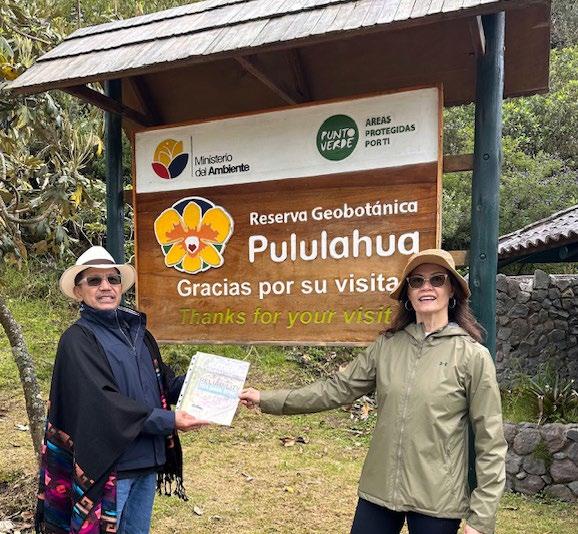
On their way to the Galápagos Islands with their latest issue of CCL, Mountain View Electric members Joe and Winnie Vasquez stop for a photo at Ecuador’s Pululahua Geobotanical Reserve, north of Quito.
Show us where you enjoy CCL for a chance to win! Take a photo of someone (or a selfie!) with the magazine and share it with us on our website at coloradocountrylife.coop. Each month we’ll draw one photo to win $25. See all the submitted photos on our Facebook page, @COCountryLife

Southeast Colorado Power Association member Judy Davis holds her copy of CCL with The Wolf Hotel owner Chris McCord in Ellinwood, Kansas.
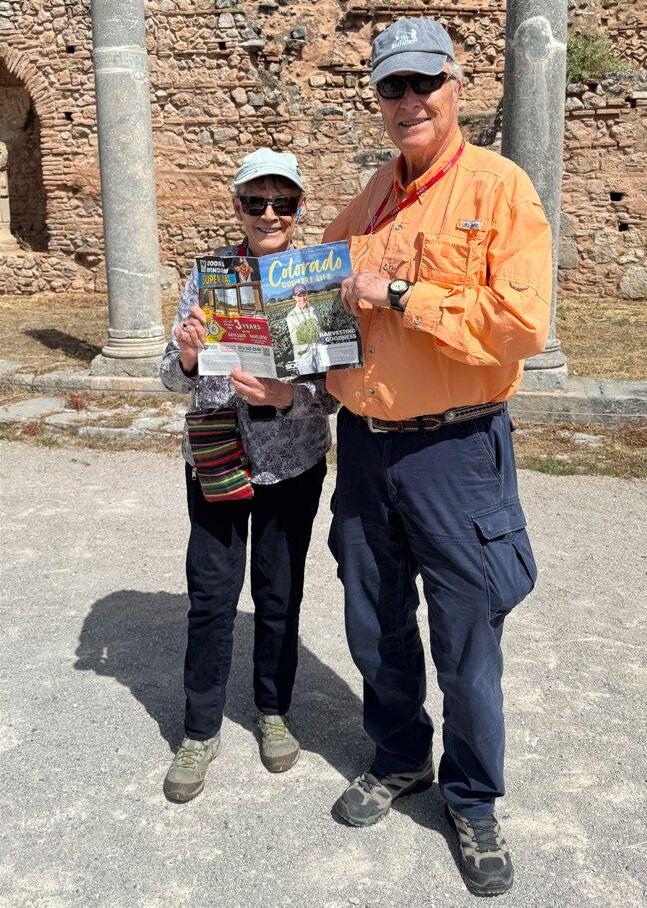
Art and Linda Wilson celebrate their 65th wedding anniversary in Greece, and visit Olympic Stadium in Olympia. The Wilsons are members of Sangre de Cristo Electric Association.
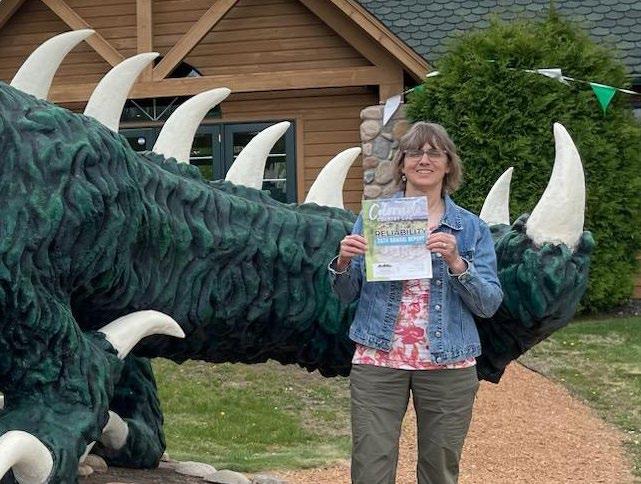
Mountain View Electric Association member Lisa Hatfield brings CCL on a visit to Rhinelander, Wisconsin. Her husband, Mark, is behind the camera taking her photo.
Wildfire risk is an undeniable part of living in the rural West, but it’s a fight we’re facing head-on.
At Tri-State G&T, we deploy data-driven monitoring and wildfire mitigation strategies to identify and mitigate risk to protect our communities and the critical infrastructure they rely on. We’ll do anything within our power to protect the people and places our members call home.
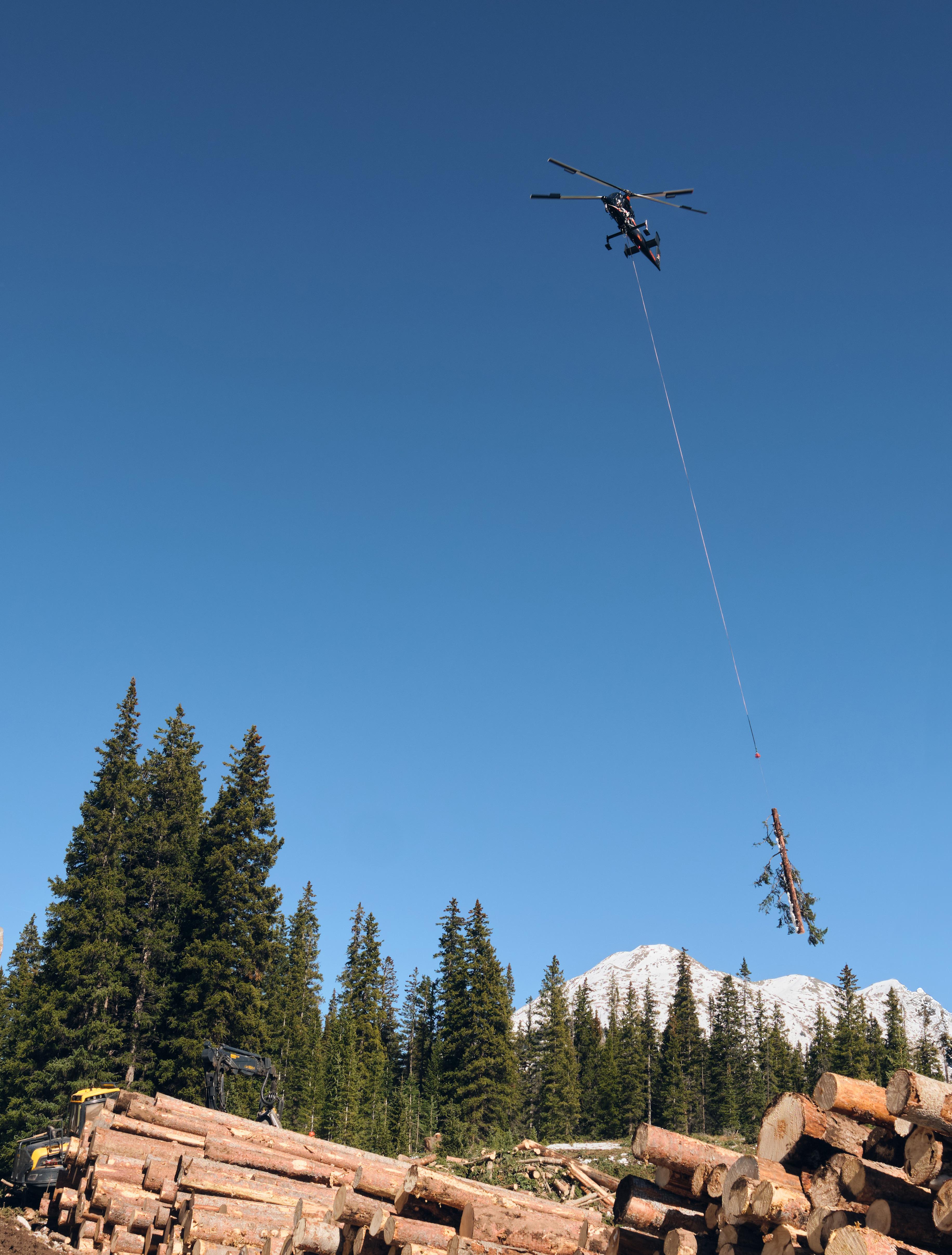
WHATEVER THE FUTURE HOLDS, WE’LL POWER IT.®
Learn more about our year-round wildfire mitigation program here:



